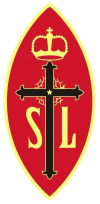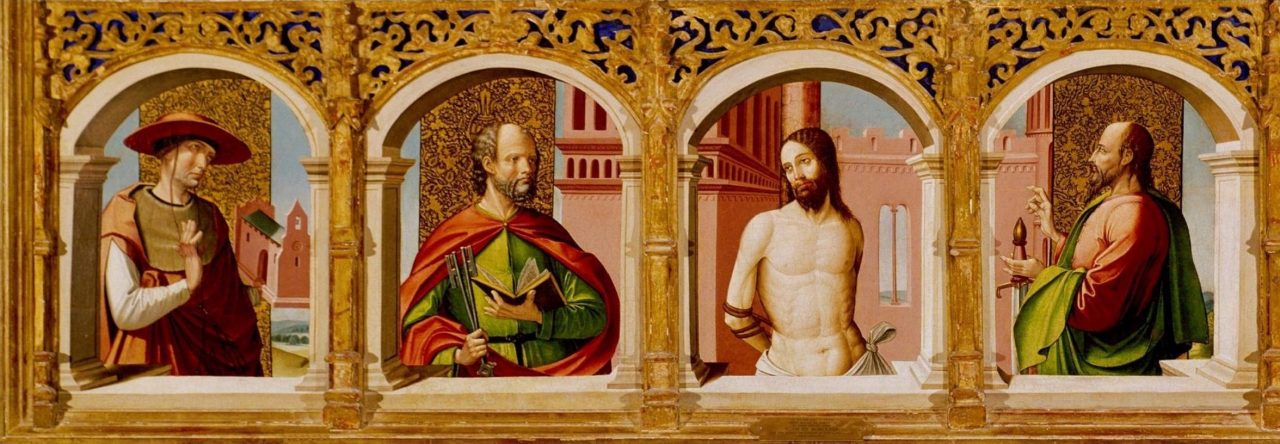STATUTES OF THE SOVEREIGN, CHIVALROUS, NOBILIARY AND RELIGIOUS ORDER OF THE CROWN OF THORNS (OCT)
(L’Ordre Souverain, Chevaleresque, Nobilaire et Religieux de la Couronne d’Epines (OCE))
1. The Order of the Crown of Thorns is conferred by the Prince-Abbot of the Abbey- Principality of San Luigi, in accordance with its re-foundation in modern times on 1 June 1891 by the 116th Patriarch of the Syrian Orthodox Church (His Holiness Moran Mor Ignatius Peter IV or Ignatius Pathros IV (1798-1894), also called Peter III without counting St. Peter the first Patriarch). He was the 116th Syrian Orthodox Patriarch between 1872 and 1894. Since 1899, the Order has additionally incorporated the Order of the Crown of Thorns created by Prince-Abbot Henrice of San Luigi on 15 October 1883.
2. The Order dates its original and traditional foundation to the Ordre du Genest founded in the year 1239 by King Louis IX of France (1214-70), who was canonized in 1297 by Pope Boniface VIII. This order was in turn inspired by the Ordre du couronne of Charlemagne.
3. The dignity of Grand Master is attached to the Office of Prince-Abbot of San Luigi, whose right it is to appoint His Successor, in consultation with the Chapter-General if He so desires.
4. The Spiritual Patrons of the Order are St John the Baptist and St Louis.
5. The Order was under the High Protection of H.M. King Peter II of Yugoslavia until his death in 1970; the High Protectorship has been vacant since then in his memory.
In 2012, the Order appointed as a Royal Patron His Majesty Rukirabasaija Agutamba Solomon Gafabusa Iguru I, by The Grace of God, Omukama of The Kingdom of Bunyoro-Kitara, Ruler of Hoima, Masindi, Kibaale, Buliisa and Kiryandongo, The Grandson of Kabalega, The Healer, The Orphan Protector, The Hater of Rebellion, The Lion of Bunyoro, The Hero of Bunyoro, The Hero of Kabalega, etc. etc. etc. – 49th Omukama of The Kingdom of Bunyoro-Kitara, 27th Omukama in The Babiito Dynasty, The Sovereign Head of The Royal Order of Omujwaara Kondo and The Royal Order of Engabu and The Sovereign Head, Grand Master and Protector of The Most Honourable Order of Omukama Chwa II. Kabalega etc. etc. etc., under Royal Bulletin 025-RB-KBK-2012. This Royal Patronage reflects the memory of His Majesty Omukama Chwa II Kabalega, who received the third Prince-Abbot and Prince Grand Master of the said Order Dom José Mendoza and the community of the Abbey of San Luigi in 1885 and granted them His Royal Protection.
6. The Order maintains its Secretariat in the United Kingdom.
AIMS OF THE ORDER
7. The chief Aims of the Order are
(1) to defend the Christian Ideology, Tradition and Cultural Inheritance;
(2) to preserve the best ideals of Knighthood of past centuries and the noble spiritual virtues of the Knights Templar; and
(3) to help forward any charitable works under the Patronage of the Order.
The Order also has the aim of rewarding persons who have distinguished themselves in defence of the Church, of humanity, or in philanthropic work initiated by the Order and have shown a Christian spirit, a clean life and a noble example.
8. The Order seeks to encourage in its members a spirit of active Christian charity and service.
DIGNITIES OF THE ORDER
9. The Order functions as the superior of the San Luigi Orders, and membership is confined to baptised Christians. The Order seeks in general to reward persons who have distinguished themselves in defence of the Church, of humanity, or in philanthropic work, and have shown a Christian spirit, a clean life and a noble example.
10. The Order confers the following Dignities upon those admitted to its membership, with the French and then English post nominal shewn:
a) Companion (Compagnon) (French CompCE, English CCT)
b) Knight/Dame (Chevalier) (French CCE/DCE, English KCT/DCT)
c) Knight/Dame Officer (Chevalier Officier) (French OCE, English KOCT/DOCT)
d) Knight/Dame Commander (Chevalier Commandeur) (French CCCE/DCCE, English KCCT/DCCT)
e) Knight/Dame Grand Cross (Chevalier Grande Croix) (French GCCE, English GCCT)
The Collar of the Order is its supreme accolade and is conferred rarely, principally upon Heads of State and Heads of Royal Houses.
11. Those admitted at the rank of Knight or Dame or above are entitled to use the prenominal Chevalier (or Dame) (except if clergy) and to append to their names the appropriate post nominals. At the discretion of the Grand Master, membership of the Order may be granted on a hereditary basis with remainder to the senior male-line descendant of the holder.
12. The Order may grant various other titles under certain conditions. Members who are Catholic, Orthodox, or Anglican clergy are eligible for advancement as Prelate, Canon or Dean of the Abbey of San Luigi. The title of Doctor Christianissimus (D.C.) has been established within the San Luigi Orders since their early years and is today conferred upon senior Catholic and Orthodox clergy who are members via the Western Orthodox University, Florida, USA, which is described elsewhere.
13. Ladies admitted to the Order, in the different Ranks from that of Dame upwards, receive the Title of “Dame d’Honneur et Devotion de l’Abbaye de San Luigi”. Those admitted as Grand Cross receive the Title of “Chanoinesse d’Honneur de l’Ancienne Abbaye de San Luigi.”
CHARACTER OF THE ORDER
14. The Order is International in character, and is represented in various countries by Dignitaries whose duty it is to propose those persons who desire admittance to the Order, and to be responsible for the organisation of the Order in their respective territories.
CONDITIONS OF ADMISSION
16. Candidates must be baptised Christians who subscribe to the Nicene Creed in its natural interpretation.
17. Nomination of a candidate should be addressed to the Grand Master, which may be made directly only if the country in which the candidate lives does not have an Official Representative. The application should clearly set forth the basis for the award according to the candidate’s achievement in furthering the Aims outlined above.
18. The Grand Master, either directly or through His Representatives, makes inquiry into each application, and later renders His decision; which, whether favourable or unfavourable, is final and not subject to question. If unfavourable, such decision is not to be interpreted as being in any way a reflection upon the candidate.
19. The Grand Master has the right to grant admission to the Order to anyone of His Own choice, without necessarily requiring the complete fulfilment of these Regulations. As He confers all the Offices and Dignities granted within the Order, so He may revoke them without having to give any reasons for His decision.
DUTIES OF MEMBERS
20. Members of the Order are expected to propagate the Order and its interests by every proper means in their power. They are required to maintain contact with the Grand Master or His Representatives, and to advise promptly of any change of address. They are required also to avoid all political entanglements or discussions in their capacity as members, whether collectively or singly.
21. On 1 January each year, members are liable for an annual Oblation in amount as may be fixed from time to time. Serving clergy and others who are on limited incomes may be exempted from this obligation at the discretion of the Grand Master. Members who do not meet this obligation, not having been exempted, will be considered inactive and may not use the designations of the Order or wear its Insignia, nor attend its meetings, until such time as they have discharged their liabilities. The payment of Oblations is to be administered according to the strict instructions of the Grand Master and no third party not authorized by him may collect Oblations from members.
22. In the general course of events an annual Investiture of the San Luigi Orders will normally be scheduled at which new members may be formally invested by the Grand Master. In addition, such occasions will normally include a collection to be allocated to those worthwhile and charitable causes supported by the San Luigi Orders. Additional meetings will be held as circumstances warrant.
INSIGNIA OF THE ORDER

1891 depiction

Modern illustration
22. The Cross (Star) of the Order is a Cross of Jerusalem in white enamel edged with gold, surmounted by a shield of blue enamel bearing the monogram of Christ (the Chi-Rho) in gold, and surrounded by a Crown of Thorns also in gold. The ribbon is watered red with narrow white edges.
23. The seal of the Order:

24. The Flag and the Banner of the Order is of silk, half white bearing the Fleur de Lys and half red bearing the Crown of Thorns, with the monogram of Christ in the centre.

 UNIFORM OF THE ORDER
UNIFORM OF THE ORDER
25. All members of said Order, and others having connexion with the Abbey-Principality with permission from the Grand Master, may wear the authorized uniform of the Abbey-Principality which is as set out in the appropriate Protocol.
26. Members are responsible for the purchase of uniforms and insignia from the Order’s approved suppliers and for all costs incurred in so doing.
Approved this twenty-sixth day of January in the year of Our Lord two thousand and twelve and revised this first day of May in the year of Our Lord two thousand and twenty-three:
++EDMOND P
Prince-Abbot of San Luigi
Mukungu of the Chieftainship of the Ancient Abbey-Principality of San Luigi (Fizzan)
Grand Master of the San Luigi Orders


You must be logged in to post a comment.